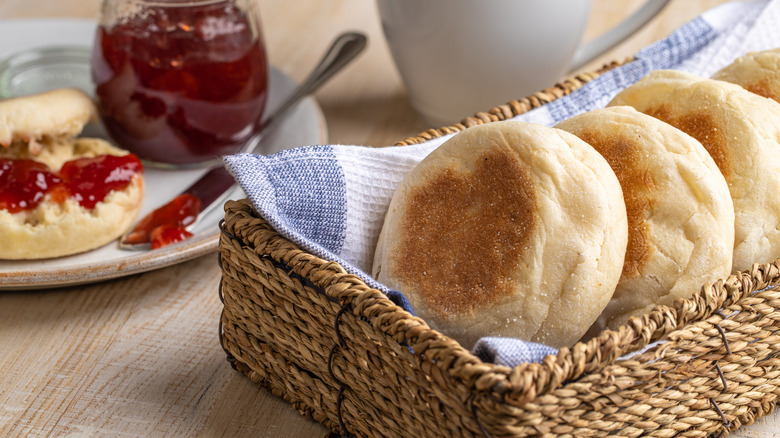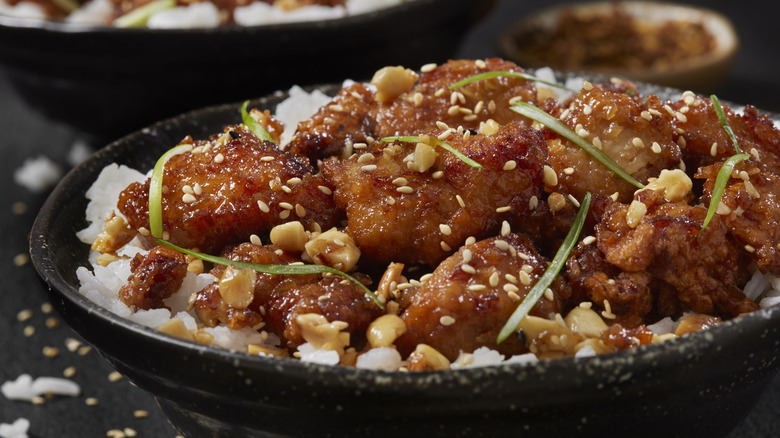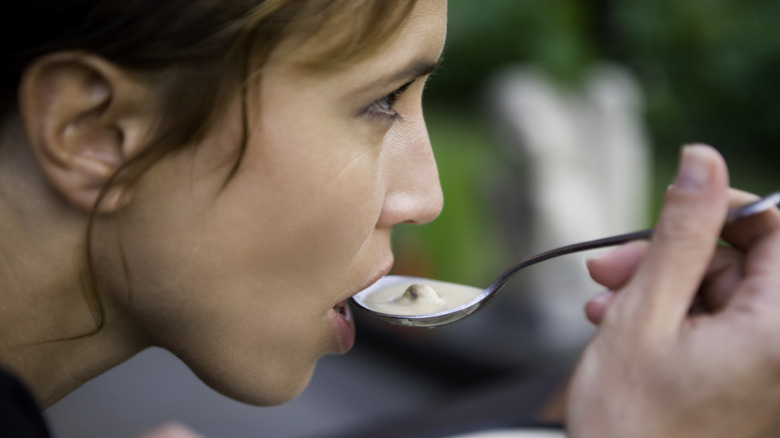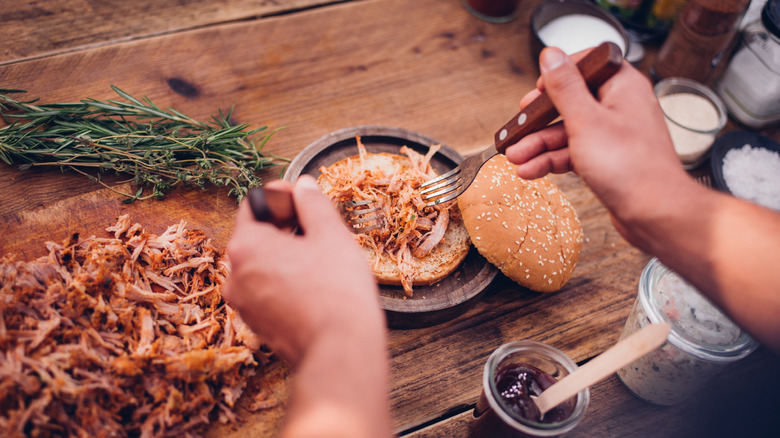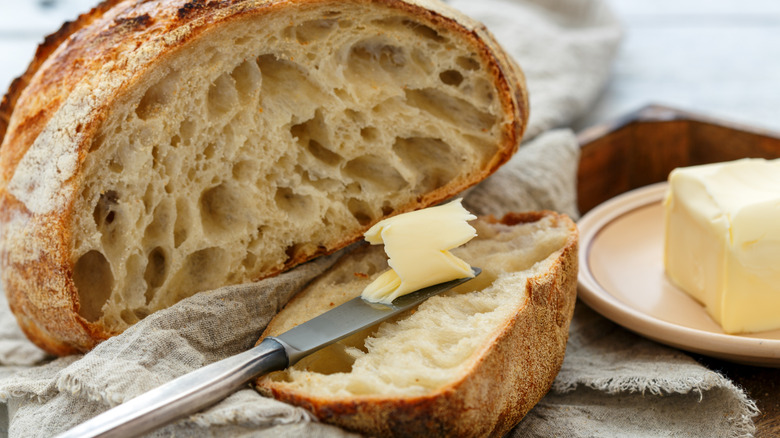Foods You've Probably Been Serving Wrong This Whole Time
You probably assume that you're serving food correctly when serving yourself, family, or friends, particularly if you're serving something that's a no-brainer. Ice cream? Cake? You've eaten them a million times; it doesn't take a rocket scientist to figure out how to serve them. If you were serving something truly out of your wheelhouse and unfamiliar (snails, maybe?), then you'd consult the experts. Otherwise, you've got things covered... But what if you're wrong?
Turns out, there are some pretty simple, everyday foods that are intended to be served a certain way, and most of us aren't following the rules. While, sure, some of these rules and standards are purely etiquette-based or stem from long-gone ideals of what's proper and what's not, others are pretty smart, and choosing to follow them will ensure a better, potentially tastier, or less messy dining experience. So, are you ready to see which foods you may have been serving incorrectly this whole time? Get ready to learn a thing or two.
English muffins
Toasted, covered in melted butter that seeps into all the nooks and crannies, maybe with a slathering of jam or preserves — an English muffin makes a delightfully delicious breakfast. However, if you're using a butter knife to slice open your English muffin before toasting, topping, and serving, you're doing it wrong. Using a butter knife for this purpose smooshes the bread, leaving the muffin's texture worse for wear.
So, what's the correct way to serve an English muffin? Differing opinions point to one of two options, but whichever you choose, it's definitely better than the butter knife method. Before serving, split the English muffin and toast and top it like you normally would, but leave the butter knife in your cutlery drawer. To split the muffin, either use a fork and slide the tines into the muffin's perforated sides, gently breaking the two sides apart, or take the muffin in hand, press your fingers into the perforation, and twist, tearing the muffin in half.
Oranges
Oranges make a great, healthful addition to a brunch or breakfast spread, but serving your family or guests oranges can result in more mess than not. It's not like you can just take a big bite out of your orange and go on your way. No, you've got to break through the tough exterior first, getting the skin all under your fingernails. Then you have to painstakingly peel it; all the while, sticky juice is running down your arms.
So, what's the best way to serve oranges without the mess? Before serving, do a little prep work. Take a paring knife and cut through the orange's skin, not pressing deep enough to cut into the flesh. Pull the paring knife around the orange's circumference. Then, using the gap you've created, work the two sides of the skin free until they pull loose in two, whole, equal parts, leaving you with a perfectly un-punctured, spherical, peeled orange, all intact and ready to eat in segments, no peeling required.
Korean food
Whether you're ordering takeout or trying some new recipes at home, if you're serving Korean food, don't make the mistake of thinking that Korean food is all Korean barbecue. If you want to serve up a truly traditional Korean feast, you need to take a bit of advice from Iron Chef Judy Joo.
As Joo told Mashed in an exclusive interview, traditional Korean food centers around the number five. Any traditional meal needs to represent five different flavors, five different textures, and five different colors. According to Joo, if you can achieve this, the theory is that you'll be eating a well-rounded meal that's not only varied and delicious but also meets all your nutritional needs. So, the next time you start planning a Korean feast, consider incorporating some of the Korean dishes you didn't know you should be ordering for a full range of flavors and greater authenticity.
Spaghetti
If you order a plate of spaghetti somewhere that's slightly more upscale than a chain restaurant, your spaghetti will likely be served with a spoon on the side of the plate. Because of this, you may have assumed that eating your spaghetti with the help of said spoon in order to actually get your pasta onto your fork is the "correct" way to go about it. However, that's not necessarily the case, and if you serve a spoon with your spaghetti at your dinner parties, you need to stop. According to an Instagram post from expert Myka Meier, correct spaghetti etiquette demands you lose the spoon. Additionally, if you serve your pasta along with a knife, the knife should go, too. Tradition demands you not cut your spaghetti, linguine, fettuccine, etc., but twirl every time.
When plating the pasta for serving, don't plate the pasta, then add the sauce, then the cheese, all in layers. Instead, combine the pasta and sauce on the stove and serve the pasta already tossed in the warm sauce. When it comes to cheese, serving your pasta with a sprinkling of cheese grated right at the table seems like a great choice, but it's not always the right one. If your pasta dish contains fish, the cheese is a big no-no, as it's believed it will overpower the seafood's delicate flavor.
Ice cream
If you've ever served ice cream at a party, you might've suffered from some seriously sore muscles after scooping out more than a few frozen mounds of ice cream, using just a little elbow grease and your trusty scooper. However, there's a better way to serve ice cream and save your strength in the process, and no, it doesn't just include warming up the ice cream scoop so that it more easily cuts through the ice cream.
Instead, ditch the scoop entirely and use a knife to serve your ice cream. If your ice cream comes in a paper (not plastic) carton, you can simply lay the carton on its side and use a sharp, long knife to cut the carton into slices. Once sliced, peel away the carton to reveal your ice cream "slices" beneath. Not planning on serving the entire carton? No worries. You can store the leftover ice cream the same way you would homemade ice cream — in a very small container (the less air, the better) and in a very shallow container for quicker freezing and less freezer burn.
Avocados
Much like oranges, avocados aren't exactly a mess-free fruit (and, yes, avocados are a fruit) to serve as part of a breakfast buffet or on the side of a Tex Mex-inspired dinner, particularly if you aren't turning the avocados into something like guacamole. Dice or slice them ahead of serving, and not only do you risk the avocados turning brown before they can be devoured, but it's also quite likely that the avocados will be more or less smashed in the serving process.
For avocados that hold their shape but to avoid just handing your diners a whole avocado and wishing them luck, follow Nick DiGiovanni's hack, which he shared on YouTube. He recommended peeling the skin off your avocados for easier slicing and eating at the table. Each person can season the avocado as they like, cut and slice it into bite-size pieces, and eat around the pit. (Is it a joke? Yes. Is it genius? Quite possibly.)
Soup
Soup is a part of just about every "fancy" meal. The soup course is a thing, after all, and it only exists in certain settings. You're not getting a soup course at your local diner; maybe a cup of chili or chicken noodle, yes, but no soup course. Soup is often fancy! And it's also messy, can be loud, and isn't always the best choice in every situation.
If you want your soup-serving experience to be fancier and less slurpy, more five-star and less diner-esque, brush up on etiquette expert Emily Post's rules for serving soup, as detailed by the Los Angeles Times. Post's rules for serving soup are clear. Serve the soup first as part of a multi-course meal. If it's lunchtime, serve the soup, preferably a clear soup, in a two-handled cup. Otherwise, clear soups always go in shallow bowls, not cups; with both, saucers or plates should also be used beneath the cup or bowl. If it's dinnertime, serve a soup made with sherry, as sherry should be the first wine served at a dinner. (Do note that Emily Post died in 1960, though, so, if you really can't stand the thought of sherry-based soup, go wild and serve something else; we won't tell.)
Cake
Birthdays, office parties, baby showers, wedding showers, gender reveal parties — what do these events have in common? They usually include a cake. However, unlike a catered party like a wedding reception, wherein a professional is around to cut said cake, these lower-key events leave the cake serving up to you. So, are you serving your cake the "right" way?
When serving a round cake rather than a sheet cake, many of us just eyeball the cake and cut a singular triangle. However, there's a better way to go about this, for more even slices all the way around. Instead of cutting the cake slice by slice, start by cutting the entire thing in half. Then, cut the halves in half for four pieces. Then, cut those pieces in half. Keep going until you have the desired number of pieces of cake. This will give you completely even slices ready to serve without the need to stop and slice each new piece as you serve it.
Shredded meat
Whether hosting a potluck, taco night, or game day get-together, if you're serving shredded meat, such as for tacos or sliders, you need to prepare your shredded meat the right way for the easiest experience possible for your guests.
Whatever you do, don't just serve a hunk of meat and expect your guests to do the shredding on their own. However, don't feel like you have to invest in gimmicky shredding tools to achieve that perfect, even shred throughout your roast or tenderloin, either. Instead, pull out your handy stand mixer before serving. Just cut your roasted meat into rough chunks, drop the chunks into the stand mixer, add a little broth, and then let the stand mixer's paddle attachment do all the work for you. No stand mixer? Use a blender or food processor instead. From there, serving is as simple as laying out your succulent shredded meats so guests can help themselves.
Butter
Butter's not just for baking. Serving butter with a selection of breads and other accompaniments can make for a simple yet oh-so-satisfying start to a meal. That said, don't just assume that because this option is simple, you can serve butter any ol' way. While some restaurants may merely throw down a basket of bread alongside some little foil-covered pats of butter, you can do better.
Follow Alex Guarnaschelli's example and serve your butter with a bit of extra care. As she detailed in an Instagram post, leave your butter out of the fridge ahead of time to come up to room temperature, and before serving, top it with pepper and sea salt for a textural match made in heaven. Want to upgrade the experience further? Serve a butter board. All it takes to assemble the perfect butter board is high-quality butter and a mix of tasty toppings, including cheese, fresh herbs, spices, seasonings, and a range of textures.

